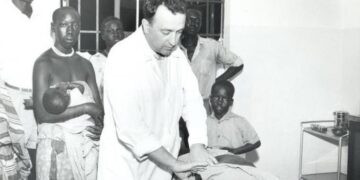In 2019, a 7-year-old budding singer known by his stage name, Fresh Kid (Patrick Senyonjo) was sourced by producer, Francis Kamoga from a rural village in Luweero district to Kampala to begin singing as a career. Fresh Kid performed late at night, in bars and at nightclubs. All proceeds from his performance went to taking care of his family and part to Manager Francis. The Minister of State for Youth Affairs, Hon. Florence Nakiwala Kiyingi intercepted and warned Fresh kid from performing during school hours and late in the night. After this declaration, a lot of controversies broke out with people criticising the minister for sabotaging talent and others criticising the manager and his parents for using Fresh kid to earn money to pay the family bills.
However, this did not only stop with Fresh Kid. The two-year lockdown caused by the Covid-19 pandemic saw many children involved in various petty jobs and activities, ranging from; selling vegetables, face masks, fruits, to breaking stones in quarries and some working in plantations and people’s homes as shamba boys and house helps. Many did not know that it was child labour but a way in which children help bring income to the family. According to Ugandan Labour laws, no child under 18 years should work. In addition, Uganda’s constitution Article 59, clause 56, line 8 restricts young children below 18 from being used for any financial benefits.
International Labour Organisation (ILO) defines “child labour” as work that deprives children of their childhood, their potential and their dignity, and that is harmful to the physical and mental development of the child. It refers to work that: is mentally, physically, socially or morally dangerous and harmful to children; and/or interferes with their schooling by depriving them of the opportunity to attend school; obliging them to leave school prematurely, or requiring them to attempt to combine school attendance with excessively long and heavy work. “The major reason why children and parents are involved in child labour is poverty and these children are good at marketing,” commented Mr Kayizi John, a resident of Mukono.
Nakityo Jane, a resident of Lugazi working in a quarry says, “If these children don’t help me in the quarry, I cannot manage alone because I need to break stones that can fill a pickup truck in a week so that I am able to earn Ugx 60, 000.”
Lekuru Agatha on the other hand says that whenever she boils maize cobs for sale, she also packs some in the small saucepans for her 7 and 9-year-old children to hawk so that the stock can get finished quickly, otherwise, her selling point alone is not enough. This kind of work ILO calls child labour but to Lekuru, these children are simply helping her and she is training them how to survive in the wild world.
According to the 2016/17 Uganda National Household Survey, more than 2 million children are engaged in child labour. Of these, more than 1,000,0000 children (age 14-17 years) are involved in the worst forms of child labour doing work in hazardous conditions—including working in extractive industries (including mines), working with chemicals and pesticides in agriculture or with dangerous machinery. Some are toiling as domestic servants in homes. The proportion of children in hazardous work was more than double in urban areas as compared in rural (Urbanization: Emerging Global Challenges, 2018).
Another report on the ILO website states that with the world’s 160 million children, 63 million girls and 97 million boys are involved in child labour accounting for almost 1 in 10 of all children worldwide. And nearly, 79 million children are in hazardous work directly endangering their health, safety and moral development.
Child labour prevalence across regions stands at 24 per cent in sub-Saharan Africa, three times that of Northern Africa and Western Asia, the region with the second-highest prevalence. ILO further states that 87 million children in child labour in sub-Saharan Africa are more than in the rest of the world combined. In the last four years, for the first time since 2000, the world did not make progress in reducing child labour. The absolute number of children in child labour increased by over 8 million to 160 million, while the proportion of children in child labour remained unchanged.
Uganda’s national child policy 2020 states that, “Child protection is about the protection of children from abuse, neglect, violence and exploitation.” Article 19 of the UN Convention on the Rights of the Child also provides for the protection of children in and out of the home environment. Despite all these laws, the level of poverty does not give these children the privilege of being protected both by their parents and the government. The National policy is quoted in parts stating that Child labour violates children’s rights and remains a serious issue in Uganda. It is reported that presently, the world is not on track to eliminating child labour by 2025. ILO says in order to meet the target, global progress will need to be almost 18 times faster than the rate observed over the past two decades.
ILO also states that, “More than one-third of all children in child labour are excluded from school…” Nearly 28 per cent of 5 to 11-year- olds and 35 per cent of 12 to 14-year-olds in child labour are out of school. Boys and urban children in child labour are slightly more likely to be out of school.
The intersection of the Covid-19 pandemic with child labour globally offers substantial cause for concern. In 2020, the pandemic increased the number of children in income-poor households by an estimated 142 million, adding to the 582 million children already in poverty in 2019.
Human Rights Watch, collected testimonies from 81 children in Ghana, Nepal and Uganda who had been pushed into child labour or endured more difficult work circumstances. Some indicated that their families no longer had sufficient food and they were working to get enough to eat. Children said that their work was frequently long and arduous – one third in each country had to work for at least 10 hours a day, and some described working for as many as 16 hours.
The report further predicts that 46.2 million additional children would enter child labour by the end of 2022. Child labour negatively impacts child health and education—impairing their
opportunities for normal growth and development. ILO states that, whether or not particular forms of “work” can be called “child labour” depends on the child’s age, the type and hours of work performed, the conditions under which it is performed and the objectives pursued by individual countries. The answer varies from country to country, as well as among sectors within countries.
By Irene Lamunu
















